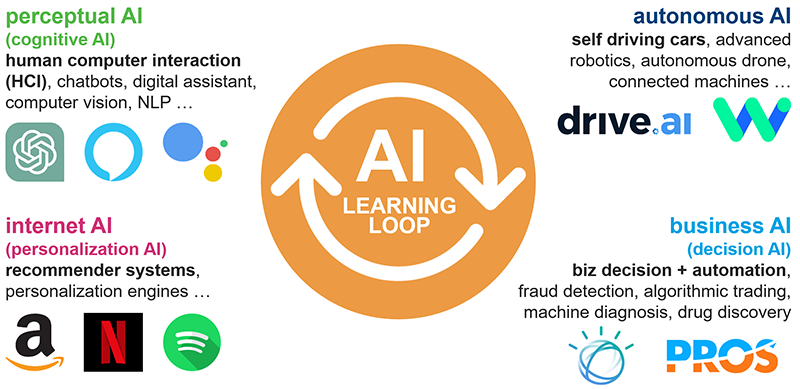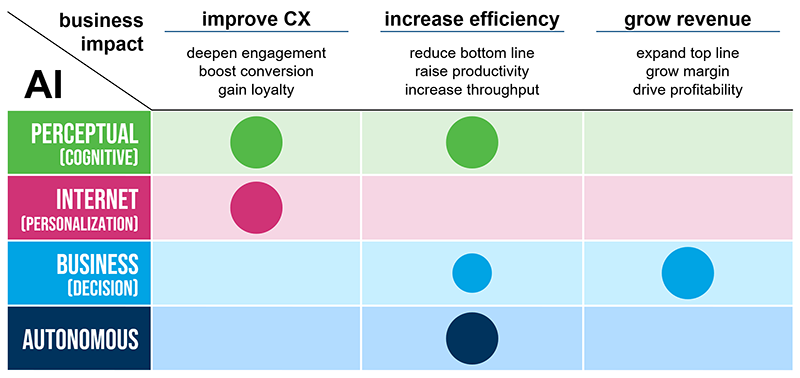Choosing the Right AI for Your Business Goals
The interests and investments in AI have skyrocketed since the introduction of ChatGPT. Meanwhile, many businesses are still wrangling with the shift to an increasingly contactless operation in the post-pandemic world. These market forces propelled traditional industries to accelerate their adoption of digital technologies. These global disruptions are going to have a lasting impact on the way we work.
Artificial intelligence (AI) is one of the most powerful tools that can accelerate an organization’s digital transformation and ultimately transition to contactless remote work. To leverage AI, business leaders need a clear understanding of which type of AI is best suited for their organization’s goals. Therefore, business executives looking to execute a successful digital transformation must have a clear understanding of the AI market landscape and what kind of business impact they can drive.
The 4 Major Categories of AI Applications
There are literally thousands upon thousands of AI systems today. Before getting started with your digital transformation efforts, it’s important to understand the major categories of AI applications on the market. And the 4 most important categories of AI that have demonstrable business impacts in the near future are: Perceptual AI, Internet AI, Autonomous AI, and Business AI.
Perceptual AI (a.k.a. cognitive AI) specializes in mimicking the higher cognitive function of human beings, such as speech, language, and vision. The primary application of perceptual AI is in human-computer interaction (HCI). Like the highly popular ChatGPT by OpenAI, Amazon’s Alexa, Apple’s Siri, and Microsoft’s Cortana, they endow machines with an understanding of our language and speech, so we can interact with machines using simple voice commands without needing to write any codes.
Internet AI (a.k.a. personalization AI) makes use of the digital trails we leave behind when we browse, shop, and consume digital content on the internet to understand our individual preferences. For example, Netflix and Spotify utilize this class of AI to recommend content to users. In business, this AI is not only used to offer personalized offers and recommendations, it can also be used to provide consumers a unique digital experience.
Autonomous AI is the AI behind the self-driving car. It is actually a collection of many machine learning (ML) models working in concert to power machines, robots, drones, and other autonomous systems, giving them the intelligence to react to a wide enough range of possible situations and resolve conflicts among themselves, so all the ML components can function harmoniously with minimum human intervention. In business, this class of AI is the key to all robotic process automation.
Business AI (a.k.a decision AI) is the most esoteric and domain-specific, because they are used by highly specialized individuals in different business domains. This class of AI is also the most diverse, with a very wide range of potential use cases, including fraud detection, algorithmic trading, dynamic pricing, automated drug design and evaluation, machine-aided medical diagnosis, etc. However, its primary application is simple. It helps with business decision automation, which not only enables faster but also better (more optimal) business decisions.
Identifying Your Business Goals
Once teams have a firmer understanding of the different AI systems, it’s time to identify core business objectives to determine how to get the most out of these AI. As there are thousands of AI applications, their business impacts are equally numerous. However, we have categorized 4 of the most important classes of AI, so we can also summarize the business outcomes that AI can drive into 3 most important business impacts:
- improving customer experience
- increasing efficiency
- growing revenue
Improving Customer Experience (CX) is already a top priority for many companies even before the pandemic. In an increasingly digital world devoid of human touch, good CX is key to winning customers and their repeat business. Some business goals that are well-aligned with improving CX include deepening engagement, boosting conversion rate, or simply gaining customer loyalty. If your goal falls into any of the above categories of business outcomes, then there are 2 classes of AI that can directly help you achieve them.
For example, perceptual AI can provide customers with a more engaging and interactive experience on digital channels through the use of conversational AI (i.e. chatbots and digital assistants). These conversational agents can also guide customers to more relevant content faster, giving customers a concierge experience. Both of these improve CX. Internet AI can also play a crucial role in improving CX by recommending personalized content, products, and services to customers based on their preferences. This allows businesses to further personalize the presentation and delivery of the most relevant content to their customers, driving conversion and loyalty.
A notable example is Amazon’s innovative use of computer vision in its Amazon Go store, a convenience store that has no lines, no checkouts, and no registers. Simply scan your account to enter, walk in with your friends, grab what you want, and walk out. This significantly improves the CX when shopping in a store, and it’s going to drive engagement and loyalty like nothing we’ve ever seen before.
Increasing Efficiency is usually top of mind for businesses in times of crisis, because when resources are scarce, all businesses must learn to do more with less. Some business goals that are well-aligned with increasing efficiency include reducing cost, raising productivity, and increasing throughput. If your goal falls into any of these categories, then there are many AI that can help, because this is a very crowded space. Many AI tools are designed and built to help automate slow or broken business processes to make them more efficient.
Perceptual AI can boost productivity and operational efficiency when used internally with employees. With the help of digital assistants, employees can virtually work anytime, anywhere by using simple voice commands so digital assistants can take care of time-consuming, routine tasks and complex calculations. Autonomous AI can also improve your efficiency by automating physical tasks with machines that can operate 24/7 with little downtime. Finally, business AI can also help here, because it can automate difficult decisions that would normally take a long time, because they may involve many analyses of huge amounts of data. This will allow decision-makers to reach a decision much faster.
Growing Revenue and even recouping losses is of paramount importance for companies to stay in the game. Some of the business goals that are perfectly aligned with growing your revenue include improving your margin, driving profitability, and expansion of your top line. Now, if your goals fall into these categories, which AI can you leverage?
This is where business AI shines the most. As mentioned earlier, by applying this type of AI, humans can work in tandem with algorithms to make business decisions faster. However, business AI also helps you grow revenue by arriving at a more optimal decision. For example, a small price change of 1% in a more optimal direction could lead to as much as 11% margin improvement. It is often challenging, even for experienced pricing experts, to determine the optimal price for a certain product or service due to the number of factors involved and their interdependency. However, AI can analyze vast amounts of data in real-time and quickly converges to an optimal price.
Conclusion
As with any technology choice, the best AI for you depends on what you want to accomplish with it. The figure below illustrates the most appropriate AI for the business impact you want to drive. An important point to note is that this doesn’t mean perceptual AI cannot drive revenue growth. It certainly can! However, the impact is not direct. Perceptual AI improves CX, consequently, customers will love to engage with brands that use this AI well. Deeper engagement builds stronger customer relationships, as a result, customers become more loyal. This ultimately leads to repeat businesses and then ultimately revenue lift.
Evidently, all 4 different types of AI can play a role in helping a business accomplish each of the 3 outcomes in their own way. However, the most direct mechanism with immediate impact is illustrated as the largest dots in the figure above. Moreover, different types of AI can be combined to achieve multiple outcomes or more optimal outcomes for a business. Seamless integration that results in frictionless usage (by both customers and employees) is key to success in this case.
No two businesses are exactly alike. Therefore, business leaders must make the effort to thoroughly understand their own business needs and the goals they are trying to achieve before choosing the AI tool to drive those business goals. There’s no “one size fits all” approach.
DISCLAIMER: The content of this article was first published by CMS Wire. Here is the latest revision and a current rendition of the raw manuscript submitted to the publisher. It differs slightly from the originally published version.




